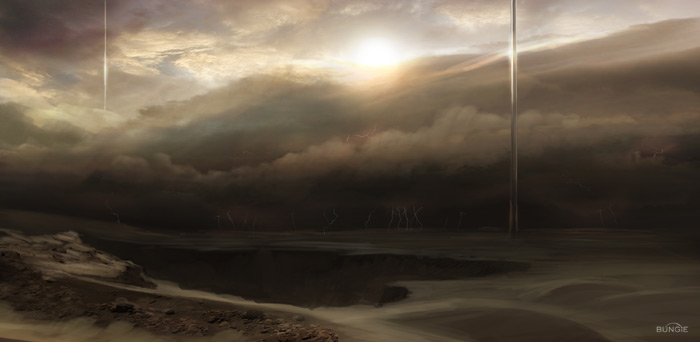
As we roll on through the ancient rubble that is Halo 3’s multiplayer map set, we turn our attention to Justin Hayward. Last we spoke he was talking about bringing Halo 2’s luxurious Midship back up to speed. To get caught up on what made Sandtrap one of the monumental stone pillars of Halo 3’s Big Team Battle play, we asked him to dig deeper into his past and uncover the mysterious origins of Sandtrap’s deserted excavation site.
It begins, as many of the multiplayer maps in the Halo 3 stable did, with scale.
“A lot of the initial, ultra massive idea for Sandtrap came from me and then, as development progressed, it slowly got scaled down.”
Hayward is looking over the design document. I’ve brought along some still shots of the mass out work he did in 2005 and Chris Carney’s top down architectural drawing. So what was the original, ultra massive idea for Sandtrap?
DIGGING IN
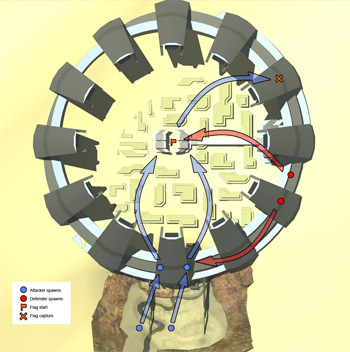 “I had a bunch of small goals. I really wanted to make the ultimate Warthog map. And make it both vehicle and infantry friendly, which is pretty problematic in Halo 3 at times. The Warthog is my favorite vehicle in any game ever and I feel like maybe half of the levels we’ve had Warthogs in have been successful. Sometimes it’s tons of fun. Sometimes it’s really -blam!-.”
“I had a bunch of small goals. I really wanted to make the ultimate Warthog map. And make it both vehicle and infantry friendly, which is pretty problematic in Halo 3 at times. The Warthog is my favorite vehicle in any game ever and I feel like maybe half of the levels we’ve had Warthogs in have been successful. Sometimes it’s tons of fun. Sometimes it’s really -blam!-.”
Hayward, though soft-spoken, isn’t prone to pulling his punches. Sandtrap began life as a very different map than what we ultimately played in Halo 3. He explains.
“Some of the early discussions within the multiplayer team led to the decision to explore an objective-based sequential gameplay experience with attackers fighting their way up into the main bowl that is currently Sandtrap. There was an initial opening into area where attackers would fight up a sort of beachhead like a D-Day kind of assault. Once they made it through that, we had some pretty fun prototypes of massive guns aiming down on them.
That was a pretty huge space just by itself. Imagine a second Sandtrap right next to the one you know.”
For those with limited imaginations, picture having to press through a perilous and objective-laden Last Resort before unlocking an entrance that leads into Sandtrap’s main bowl. You can get a better idea by looking at some of the inline imagery we’ve included.
I asked Hayward about some of the simpler 3D work we had dug up to jog his memory. These are what designers call “mass outs” – the basic elements of the space without all the graphical bells and whistles.
“These are just sort of modeling I did to get that sense of scale,” Hayward says, pointing to the gray model images, “I wanted to prove out the ideas I had for Sandtrap’s look. I was very interested in the overall concept, even though there was no real fiction behind it other than ‘Forerunner something or other.’ Forerunner Magic. They’re inexplicable sons-a-blam!-s.”
The design document goes into a little bit more detail:
Deep within the boundless dune-fields of Waypoint, the high tech Forerunner structure encases the remnants of even older Forerunner stonework.
It also notes that on Sandtrap, “it’s hotter than a dung beetle’s pooper in summertime.”
Where were we? Oh, yeah.
FORERUNNER MAGIC“There are tons of strips of metal littered throughout Sandtrap that have weird digital writing on them and I wanted those to have meaning. My hope was that people would pour over the script and try to figure it out. It’s actually the same ‘text’ that appears on Epitaph.”
When I press Hayward on the “Secret of Sandtrap,” a community generated idea that the map itself holds some deep and profound mystery that will finally unlock deep secrets long buried within the darkest places of the Halo universe, Hayward gives me the slip.
“Maybe we should let that ride.”
As far as we’re aware, the script Hayward speaks of has, so far, gone untranslated.
A SPACE ODYSSEY
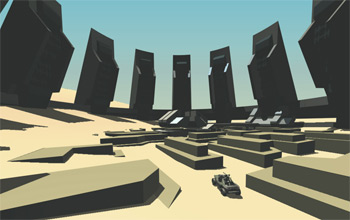 But while there was definitely some ethereal magic at play, Hayward also paid special attention to the concrete details. So, why sandstone?
But while there was definitely some ethereal magic at play, Hayward also paid special attention to the concrete details. So, why sandstone?
“I was working with sandstone because we needed a much more human scale for what we wanted to do with the very obviously Forerunner pieces. My goal with the sandstone stuff was to be mysterious. It has Forerunner shapes, but there was a debate. Certain members of the team thought stone Forerunner stuff was crap and that we shouldn’t have done it. I thought it was a great palette to work with. I wanted to work with it and I wanted the exterior metal area to feel very much like the massive Forerunner constructs that we were already used to to give it a contained sort of feel. Maybe some sort of repressiveness.”
Hayward stops to thumb an image on the concept sheet. Upper right, a Warthog sits beneath more than a half dozen looming onyx monstrosities. In this case, Hayward is content that the original vision was scaled back a little bit.
“This would have been sort of a drag. It would have been all you saw.”
Also on the concept sheet:
“Crater at center accessible by tunnels that radiate out from the pit” and “Drivable beach area extends all the way around the island.”
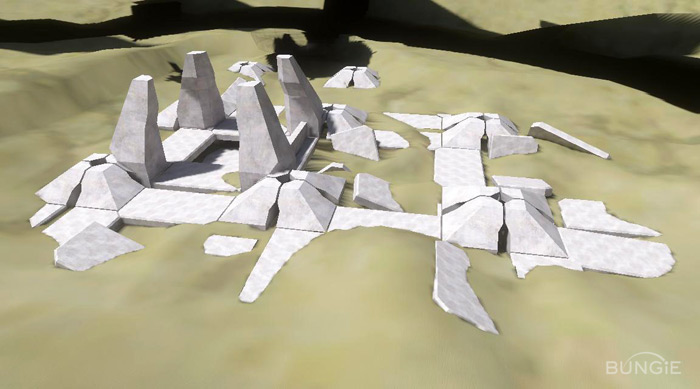
Though both concepts were eventually worked into Sandtrap in one way or another, they were ultimately scaled down for the finished product. I asked Hayward to explain the reductive nature of Sandtrap’s development process.
“We decided that this was far too large to suit any kind of capture and hold progression,” he offers, pointed at Carney’s top down blueprint. “At that time we were consolidating what Halo 3 multiplayer would be and we wanted to maintain simplicity. In that sense it fit really well with that slot we didn’t have, a large scale map with asymmetric objective.
My initial mass out of it was to sort of prove out scale. There was a real worry that this scale wouldn’t be fun. That it would take too long to get anywhere and that it just wasn’t cool. We had to ask ourselves ‘How are vehicles fun on this?’ and again, ‘How can we make both infantry players and vehicle players happy?’ As soon as you put two Warthogs on a map some people start screaming bloody murder.
Those were my primary objectives initially. I felt confident we could handle the macro gameplay. I wanted to hit the core, fun bits, to make the base gameplay really fun.”
PLAYING IN THE SANDBOX
 It should be interesting to note here that Sandtrap was emerging right alongside the game’s weapon and vehicle sandbox. Hornets and Spartan Lasers and Missile Pods?
It should be interesting to note here that Sandtrap was emerging right alongside the game’s weapon and vehicle sandbox. Hornets and Spartan Lasers and Missile Pods?
“Those were evolving as we were building Sandtrap. They were all just coming online. They all came on later than what we see here.”
Hayward points to the mass out. Then to Carney’s overhead schematic.
“By the time we got here, it was a little more locked down. We knew we would have support weapons.”
We weren’t necessarily sure how powerful they were gonna be. I think it’s different now [with Reach], there’s a lot more planning in regard to what’s gonna make it and what isn’t. We’re much more intentional. We did have to react a bit during this whole period with Halo 3’s maps.
‘Oh crap, we got this new amazing, game changing death beam thing!’
But the opposite is also true. A Warthog tooling around can die in half a second. We also have an issue where if you are in a Warthog or a Ghost and a grenade lands anywhere near you, you flip over and you’re as good as dead, so another goal for me was to make vehicle routes so they could escape as easily as infantry could."
Balancing that play on such a large scale was no small feat. Hayward took notes. He paused to read some of them so he can get his bearings while apologizing for the break. I understand. It’s been about five years since he started working on Sandtrap, a fact that catches him off guard when I remind him of the time that’s elapsed.
“Oh, my God.”
WONDERFUL TOYS
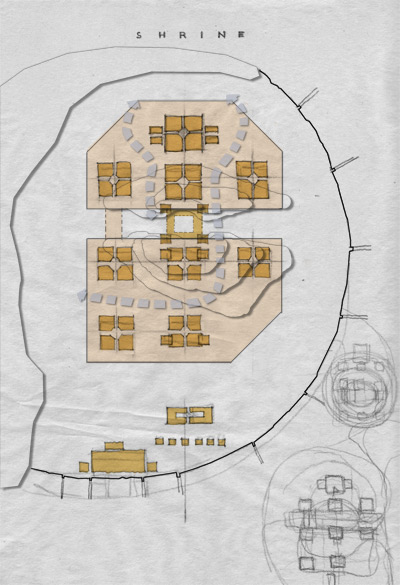 Were there any other concerns outside of the introduction of anti-vehicle measures?
Were there any other concerns outside of the introduction of anti-vehicle measures?
“There was also a fear that people would be stuck out in limbo and they’d be out of the loop. Another goal we had, working with Tyson [Green], was to throw as many vehicles in as we possibly could so there is always something nearby. You know arguably, there are still cases where you can get stranded in certain areas and you’ll get kinda screwed, but what’s nice about that open area is that you can choose your encounters a lot better.”
I ask Hayward to explain.
“Encounters on some maps tend to happen to you. You’re running and eight people see the back of your head and engage as opposed to you seeing or hearing some gunfire in front of you somewhere and saying, ‘I’m gonna progress to this pillar and then approach it under my terms.’
I think that was one benefit to building a bigger, open map. You can start at the edge and assess and choose your route as opposed to having it chosen for you. Riverworld is another map where that worked well.”
Riverworld, as astute fans already know, eventually became Halo 3’s Valhalla.
“After we proved out basic gameplay, I jumped over to Snowbound. Meanwhile Carney grabbed Sandtrap and did his classic schematic overhead of the level and did the lion’s share of the architecting so we could continue to get traction on a fairly complex map while I was off doing other stuff. Carney’s work was hugely instrumental in getting Sandtrap into a good, playable state. And then I came back on and finished architecting.”
While Hayward insists that Carney did the bulk of the heavy lifting, Carney seems to recall the setup process a little bit differently. When I poked around looking for those responsible, Carney did own up to his own work, but made it clear that Hayward tackled the majority of the mapmaking.
So what was left to do now that Hayward was back in action after Carney’s architectural assault?
“There was still a lot of sculpting to be done. What was fun about multiplayer in that point in time was that even in finishing there were a lot of design decisions still left to make. The team being as small as it was and sort of broken off of single player entirely allowed me to make some of the design decisions, even though I was tapped to do the architecting and art side of it.
How high are these sand dunes and do they actually occlude? If you’re standing on one side, does it actually keep you safe from a Warthog? I tuned a lot of these structures in Sandtrap to precisely the exact right height.” DEATH FROM ABOVESpeaking of height, I took a good look at Sandtrap’s heatmap before heading into the interview with Hayward. While most of the action is confined to the map’s inner sanctums as he predicted, there’s one outlier high along the outer rim. It’s a haven for Snipers. I asked Hayward if that perch was something he had planned for and sculpted in himself.
“Oh, yeah. The Sniper was the other big screw. Infantry getting caught out in the open and getting gunned down by vehicles was a huge concern. Sandtrap becoming a Sniper’s paradise was another. Nobody likes trying to play objective only to be sniped by a player you can’t see over and over and over. Die, spawn, die, spawn. It took a lot of convincing Tyson and Max [Hoberman] that yes, you can get out and be a -blam!-y sniper, but everyone can see you from across the map and anyone can ping you. You are on a hilltop and there’s nowhere to hide. So, you can totally do it. If you wanna be ballsy, you totally can, but you’re taking your balls in your own hands.
I was convinced that that would work. That the gameplay would weed out the chaff. If people allow that person to be a -blam!-, they’ll continue to be a -blam!-, but they only get the advantage of a high point, and that’s also a distinct disadvantage.”
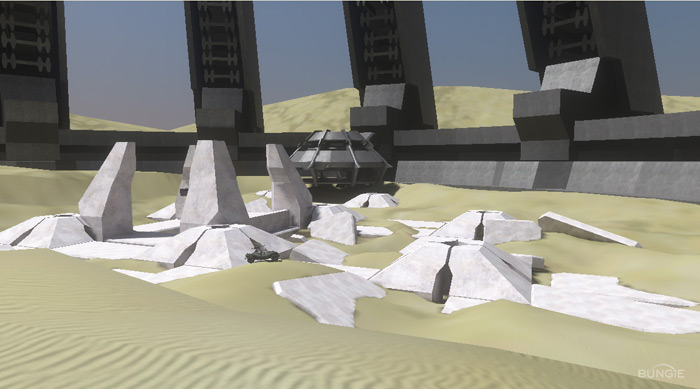
Snipers weren’t the only perched players Hayward had to worry about, either.
“Aerial vehicles were a big question mark as well – what they were and how they’d play. At the very least we wanted to have Banshees in the skies, it just seemed like a given as it open as Sandtrap is. For them too, it became pretty quickly challenging because there is no real aerial cover besides the two towers on either end. I think it developed in such a way, that aerial vehicles were a bonus, but the focus was foot traffic and ground vehicles.
They end up having the same issues as the Sniper. As soon as you lift off, you have a dominant position until everyone realizes you’re up there.”
FINAL IMPRESSIONSI sense the interview winding down. Hayward is a busy guy. He’s got plenty of work to do and I don’t want to keep him any longer than I have to. But before I let him disappear into the sunset, I thought I’d take one more shot at digging up the Secret of Sandtrap. Did Hayward really build some ultimate Easter Egg someplace inside Sandtrap’s ancient ruins?
“I probably did at some point. Some late night. I’m not gonna remember though. I do remember one particular anecdote, though:
The perimeter grenades were something that Tyson really wanted to do. Up to some point, it was lasers in the towers just like we see in Sandbox today. I was interested in lasers on high taking you out and we’d proven the system worked. The grenades were a test of another system, but they sort of stuck slightly too long and people were outrunning them sometimes. They’re not a very good barrier, necessarily.
I thought, wouldn’t it be cooler if this laser annihilated you? You hear them charging up and the eye of death strikes you down? There was sort of a general consensus that yeah, that would be cool, but we had missed our cutoff and couldn’t go back and change it.”
Hayward puts on his best producer impression.
“Something about ship dates,” he says, laughing, “but luckily we got to do ‘em both, since we eventually shipped Sandtrap and Sandbox.”
So what super secret project is Hayward hard at work on in the present day?
“Little bit of everything,” he says with a smile. “Fun stuff.”
